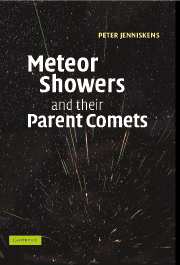Book contents
- Frontmatter
- Dedication
- Contents
- Preface
- Acknowledgements
- Part I Introduction
- 1 How meteor showers were linked to comets
- 2 What is at the core of comets?
- 3 The formation of meteoroid streams
- 4 Meteors from meteoroid impacts on Earth
- 5 Comet and meteoroid orbits
- Part II Parent bodies
- Part III Young streams from water vapor drag
- Part IV Young streams from comet fragmentation
- Part V Old streams and sporadic meteoroids
- Part VI Impact and relevance of meteor showers
- Appendix
- Tables
- Index
- Units and constants
4 - Meteors from meteoroid impacts on Earth
from Part I - Introduction
Published online by Cambridge University Press: 05 July 2015
- Frontmatter
- Dedication
- Contents
- Preface
- Acknowledgements
- Part I Introduction
- 1 How meteor showers were linked to comets
- 2 What is at the core of comets?
- 3 The formation of meteoroid streams
- 4 Meteors from meteoroid impacts on Earth
- 5 Comet and meteoroid orbits
- Part II Parent bodies
- Part III Young streams from water vapor drag
- Part IV Young streams from comet fragmentation
- Part V Old streams and sporadic meteoroids
- Part VI Impact and relevance of meteor showers
- Appendix
- Tables
- Index
- Units and constants
Summary
In the fall of 1798, University of Göttingen students Johann Friedrich Benzenberg and Heinrich Wilhelm Brandes set out to prove new ideas about the nature of meteors. In 1714, Edmund Halley had challenged Aristotle by suggesting that fireballs are not slow burning terrestrial vapors but solid objects entering Earth's atmosphere at high speed, only later to rescind. Ernst Chladni first reasoned that opinion most convincingly in 1794.
Between September 11 and November 4, Benzenberg and Brandes observed 22 meteors simultaneously from two locations 15 km apart. By teaming up in this manner, each meteor was seen from two different perspectives, against a different background of stars. Comparing star charts, they noticed to their surprise and frustration, that the parallax was much less than expected, which meant that the meteors had to be further away and above the lower layers of the atmosphere that cause the weather. This was a spectacular result! Despite the short baseline, their measured end heights were in the correct range between 35 and 126 km altitude, and they found the meteors traveling at correct speeds of some hundred thousand kilometers per hour (∼28 km/s). Unfortunately, due to measurement errors, some solutions gave upward going trajectories, and it took a re-analysis, more triangulations, and another forty years, before it was accepted that meteoroids are solid bodies that come with great speed from outside Earth's atmosphere.
4.1 How dust trails manifest at Earth
The meteoroids in a stream move on nearly parallel trajectories. Standing in the middle of it, warmly clothed in the scented night, with fog on your breath and staring at the sky, an observer on Earth sees all the meteoroids approach and, as soon as they hit the atmosphere, cause a shower of meteors to radiate from one point on the sky, called the radiant.
- Type
- Chapter
- Information
- Meteor Showers and their Parent Comets , pp. 39 - 57Publisher: Cambridge University PressPrint publication year: 2006



